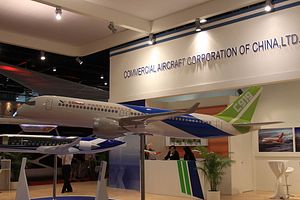On May 5, China’s first domestically manufactured large passenger plane, dubbed C919, successfully completed its maiden flight in Shanghai, despite the poor air quality triggered by a huge sandstorm from northern China.
As the plane smoothly landed in Pudong Airport after a 90-minute flight, the flight crew, wearing orange uniforms with the Chinese national flag sewn over the heart, emerged from the cockpit to applause. The captain, Cai Jun, told a reporter that the plane functioned very well and he would give the maiden flight a grade of 99 out of 100, “to be modest.”
Jin Zhuanglong, the chairman of Commercial Aircraft Corp. of China (COMAC) and chief commander of the C919 project, claimed that flying a homemade passenger plane is a “state will and national dream;” the success marks “a milestone in China’s civil aviation industry.”
The C919 plane, according to the official Xinhua News Agency, owns independent intellectual property rights for the design. Although the airplane’s engine is from foreign manufacturers, the plane’s shell — body, tail, wing — and many other fragments were made in China.
Even the name was carefully crafted: “C” stands for China as well as COMAC; the first “9” means “forever,” since the word for “nine” sounds like “forever” in Chinese; and the “19” represents the fact that the plane can host 190 passengers.
China has high hopes for C919. The country has desired to enter the global civil aviation market and become on par with Boeing and Airbus for a long time.
As early as 2005, Bo Xilai, then the Minister of Commerce, told the Europeans at a Sino-French seminar in Paris, “Because of the low profit margins of Chinese textile products, China needs to export 800 million shirts in order to buy one Airbus A380.” The comparison was immediately widely reported in China. Even now, after Bo himself ended up in prison in 2013 for a huge political scandal and his own name has become taboo in Chinese media, his famous phrase of “800 million shirts for one plane” is quoted again and again. After the maiden flight, many Chinese netizens exclaimed that the era of “800 million shirts for one plane” was over.
In 2007, Wen Jiabao, the incumbent premier, (and later to be Bo’s political rival later), approved the grand project of making China’s own passenger planes and agreed to form the large passenger plane company, COMAC. Wen emphasized on the importance of the project on numerous occasions as well:
To have China’s passenger aircraft flying in the blue sky is the will of both the state and the people. We must make this matter a success and achieve the dream of generations. This is not only the need of the aviation industry, but also the need of building an innovative nation. The development of passenger aircraft will lead to a number of technological upgrades in various major areas.
It is obvious that Wen’s words laid the foundation for current official statements.
Up till now, 23 airlines and financial companies, mostly from China, have ordered 570 C919 planes from COMAC. Although the plane still needs years of testing before it will fully enter the market, China’s longstanding ambition is already half-realized, at least in the Chinese people’s mind.
































